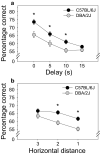Working memory and pattern separation in founder strains of the BXD recombinant inbred mouse panel
- PMID: 34996965
- PMCID: PMC8741792
- DOI: 10.1038/s41598-021-03850-3
Working memory and pattern separation in founder strains of the BXD recombinant inbred mouse panel
Abstract
Working memory and pattern separation are fundamental cognitive abilities which, when impaired, significantly diminish quality of life. Discovering genetic mechanisms underlying innate and disease-induced variation in these cognitive abilities is a critical step towards treatments for common and devastating neurodegenerative conditions such as Alzheimer's disease. In this regard, the trial-unique nonmatching-to-location assay (TUNL) is a touchscreen operant conditioning procedure allowing simultaneous quantification of working memory and pattern separation in mice and rats. In the present study, we used the TUNL assay to quantify these cognitive abilities in C57BL/6J and DBA/2J mice. These strains are the founders of the BXD recombinant inbred mouse panel which enables discovery of genetic mechanisms underlying phenotypic variation. TUNL testing revealed that pattern separation was significantly influenced by mouse strain, whereas working memory was not. Moreover, horizontal distance and vertical distance between choice-phase stimuli had dissociable effects on TUNL performance. These findings provide novel data on mouse strain differences in pattern separation and support previous findings of equivalent working memory performance in C57BL/6J and DBA/2J mice. Although working memory of the BXD founder strains was equivalent in this study, working memory of BXD strains may be divergent because of transgressive segregation. Collectively, data presented here indicate that pattern separation is heritable in the mouse and that the BXD panel can be used to identify mechanisms underlying variation in pattern separation.
© 2022. The Author(s).
Conflict of interest statement
The authors declare no competing interests.
Figures




Similar articles
-
Mouse Behavior on the Trial-Unique Nonmatching-to-Location (TUNL) Touchscreen Task Reflects a Mixture of Distinct Working Memory Codes and Response Biases.J Neurosci. 2023 Aug 2;43(31):5693-5709. doi: 10.1523/JNEUROSCI.2101-22.2023. Epub 2023 Jun 27. J Neurosci. 2023. PMID: 37369587 Free PMC article.
-
Stimulus Complexity and Mouse Strain Drive Escalation of Operant Sensation Seeking Within and Across Sessions in C57BL/6J and DBA/2J Mice.Front Behav Neurosci. 2020 Jan 10;13:286. doi: 10.3389/fnbeh.2019.00286. eCollection 2019. Front Behav Neurosci. 2020. PMID: 31998094 Free PMC article.
-
Trial-unique, delayed nonmatching-to-location (TUNL) touchscreen testing for mice: sensitivity to dorsal hippocampal dysfunction.Psychopharmacology (Berl). 2015 Nov;232(21-22):3935-45. doi: 10.1007/s00213-015-4017-8. Epub 2015 Jul 15. Psychopharmacology (Berl). 2015. PMID: 26173611 Free PMC article.
-
The Touchscreen-Based Trial-Unique, Nonmatching-To-Location (TUNL) Task as a Measure of Working Memory and Pattern Separation in Rats and Mice.Curr Protoc. 2021 Sep;1(9):e238. doi: 10.1002/cpz1.238. Curr Protoc. 2021. PMID: 34570962
-
Spatial working memory in the touchscreen operant platform is disrupted in female rats by ovariectomy but not estrous cycle.Neurobiol Learn Mem. 2017 Oct;144:147-154. doi: 10.1016/j.nlm.2017.07.010. Epub 2017 Jul 17. Neurobiol Learn Mem. 2017. PMID: 28729138
Cited by
-
Behavior is movement only but how to interpret it? Problems and pitfalls in translational neuroscience-a 40-year experience.Front Behav Neurosci. 2022 Oct 5;16:958067. doi: 10.3389/fnbeh.2022.958067. eCollection 2022. Front Behav Neurosci. 2022. PMID: 36330050 Free PMC article. Review.
-
Inbred Mice Again at Stake: How the Cognitive Profile of the Wild-Type Mouse Background Discloses Pathogenic Effects of APP Mutations.Front Behav Neurosci. 2022 Jun 23;16:868473. doi: 10.3389/fnbeh.2022.868473. eCollection 2022. Front Behav Neurosci. 2022. PMID: 35813596 Free PMC article. Review.
-
Strain differences between C57Bl/6 and DBA/2 mice (Mus musculus) in delayed matching and nonmatching-to-position tasks: impact of sample responses and delay intervals.PeerJ. 2025 Mar 24;13:e19200. doi: 10.7717/peerj.19200. eCollection 2025. PeerJ. 2025. PMID: 40151453 Free PMC article.
References
-
- Baddeley A. Working memory. Science. 1992;255(5044):556–559. - PubMed
-
- Vogel EK, McCollough AW, Machizawa MG. Neural measures reveal individual differences in controlling access to working memory. Nature. 2005;438(7067):500–503. - PubMed
-
- Mongillo G, Barak O, Tsodyks M. Synaptic theory of working memory. Science. 2008;319(5869):1543–1546. - PubMed
Publication types
MeSH terms
Grants and funding
LinkOut - more resources
Full Text Sources
Molecular Biology Databases

